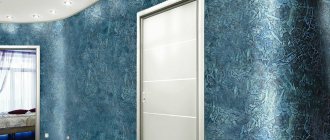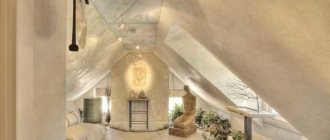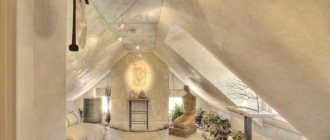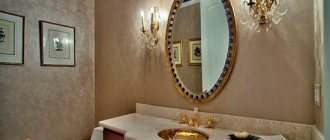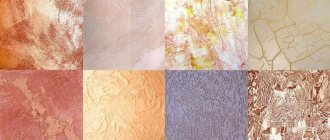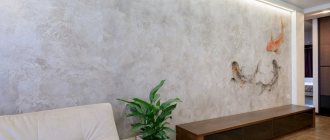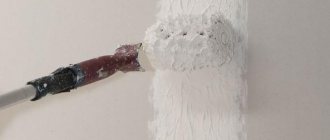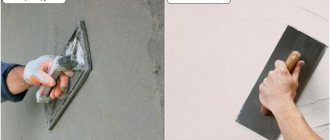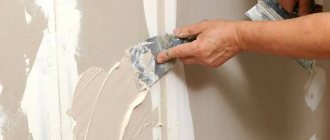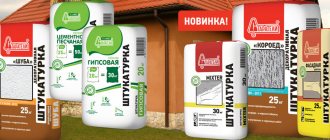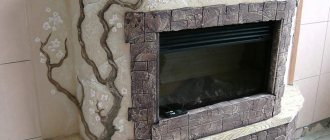In modern construction, in approximately 90-95% of cases, the most popular and in demand material is concrete of different grades and different strength classes. Its main advantages are plasticity in liquid form and excellent strength of the stone during hardening, which, in fact, is needed for architectural structures of various types. The purpose of this article is a short training course on how to make architectural concrete with your own hands and why it can be used at home.
Features of the material
Venetian is one of the types of wall decoration with plaster, which was used by the Greeks and Romans since time immemorial. Plastering surfaces with Venetian plaster allows you to imitate a valuable stone, giving the wall sophistication, grace and originality, which other materials are not capable of.
When working with Venetian plaster, it is very important to adhere to the technology of applying it to walls. To master the technique, you need to practice for some time and watch how an experienced master performs the work. If you put in maximum desire and effort, even a novice finisher can master the peculiarities of applying plaster and will be rewarded with an unsurpassed result.
Imitation of masonry in the interior
By creating the effect of stone, you can imagine different masonry. For example, masonry for finishing building facades, or imitation stone masonry for a bathroom.
Decorative plaster is successfully used for both interior and exterior decoration of the house. Inside the house, it is perfect for lining chimneys and fireplaces, columns, and partitions.
Protrusions, arches, openings and other decorative elements look great.
Brick and stone plaster for exterior finishing is used when working with plinths, fences and columns.
On the façade of a house, imitation stone looks very impressive and original, but this finishing costs much more, since the area of exterior work is much larger than the interior.
Imitation stone can be found in various places, for example, in cafes, restaurants and hotels.
There are a huge number of places in the interior where you can use the stone effect, especially since any surface is suitable for this work.
More popular surfaces are:
- Brickwork;
- Concrete walls;
- Drywall;
- Chipboard sheets;
- Expanded polystyrene boards.
Benefits of use
What is Venetian plaster?
Why is this plaster composition so popular? The most significant reasons for the demand for Venetian plaster are:
- long service life (finishing can “stand” for more than 25 years without losing its original qualities and attractiveness);
- environmental friendliness (the components are absolutely natural, which makes it possible to decorate even children’s rooms with such plaster);
- easy to maintain (such decorative material is not afraid of moisture and mechanical damage, and is not susceptible to aggressive detergents).
How to care for the surface
Decorative plaster does not require special care.
Just wipe it with a cloth soaked in water, and if dirty, with a soap solution. If the plaster is coated with wax, then chemical solvents cannot be used.
So, before using a stone, look at the options for its imitation, which have many advantages.
Preparing the necessary tools and materials
Considering that Venetian plaster is increasingly used to decorate interiors, its price is a bit steep. The table below shows the average cost of Venetian plaster.
| Type of material | Cost, rub/m2 |
| Classic | From 800 |
| Marbled | From 1200 |
| Decorating with brushes, sponges, tampons | From 600 |
| Antique | From 700 |
| Smooth finish | From 750 |
| Author's work | From 1200 |
But, there is absolutely no need to run around construction stores in search of the most budget-friendly option, because there is nothing easier than making Venetian plaster from ordinary putty.
Types of artificial stone
Only in accordance with the technology and with strict adherence to the recipe is it possible to obtain high-quality decorative building materials. Today, artificial stone is made using different methods. This allows you to obtain a material that differs in name and properties:
- Reinforced monumental stone made from concrete mortar.
It is produced individually by hand using free forming. Its production is carried out directly at the installation site. This technology allows you to create artificial boulders, granite slabs, and cobblestones.
Artificial boulder made of reinforced monumental stone Source baltiya-garden.ru
The mixture for materials is prepared on the basis of dry sand and cement. During its preparation, the components are mixed 1:3. At the same time, from 2% to 6% of pigment is also added. Its amount is calculated depending on the mass of the mixture. When preparing the solution, polymer-based additives are also used.
- Cement-sand molding stone material used during finishing and construction work.
Before you make a decorative stone with your own hands, you need to get acquainted with its properties. The material has increased resistance to low temperatures and excellent strength. The production of this type of stone can be carried out during the cold season. Typically, the manufacturing process is organized in workshops, garages and hangars.
- Artificial stone material based on gypsum.
Its casting is a simple technology that requires a minimum amount of equipment. Stone production is carried out in the warm season or in heated rooms. In this case, the material is used exclusively for internal cladding, as it is not resistant to temperature changes.
Artificial stone material made from gypsum Source prom.st
See also: Catalog of companies that specialize in finishing materials and related work
The mixture used is characterized by rapid hardening. Therefore, it is prepared in small portions, which are immediately poured into special matrices. Typically, no more than 4 minutes are spent on kneading and filling molds. In the production of such decorative stone, water is used, as well as citric acid to slow down the hardening process. Its amount is calculated depending on the weight of dry gypsum and is 1.3%.
Pigments are also used. Their amount is also calculated by the mass of gypsum and usually ranges from 2 to 6%. When selecting the optimal color option for the finished product, several samples are made, during the production of which different percentages of pigment are added to the mixture.
- Ceramic artificial stone is one of the most expensive facing stone materials.
Its production is carried out under exposure to high temperatures by firing or using the hardening method. The manufacturing process is always carried out in a heated room.
Ceramic stone in the bathroom Source pinimg.com
- Polyester decorative stone material obtained using synthetic substances.
Its production is carried out using hot hardening. Mineral fillers are used to make stone. During its production, a vacuum environment is created, which is required for curing the material. Therefore, production is carried out only in specially equipped workshops.
- Cast decorative stone made of acrylic, the production of which is characterized by cold hardening.
The material is produced using a vibration stand and strictly according to the instructions. Many of its properties are superior to those of other similar stones. In this case, it is possible to change the shape of the acrylic material when exposed to high temperatures and without loss of quality. Its maximum value is 210°C.
On a note! Decorative stone made of acrylic is characterized by the absence of pores and resistance to chemical reactions. It is able to provide a high level of hygiene. Therefore, it is often used in bathrooms, swimming pools, corridors, kitchen areas, terraces and verandas.
Decorative acrylic stone Source sense-life.com
- Liquid decorative stone material on gelcoat.
Its hardness is lower than that of cast stone. The reason for this is the smaller amount of mineral fillers used. Products of complex shapes are made from the mixture. In production, 2 types of composition are used. They differ in components and percentage of filler.
So, the primer composition of the gelcoat is 20%, and the front composition is 40%. The back compound is also used. It consists of a filler to which pigment is added in an amount of maximum 6%. The applied compounds set within 30 minutes, but decorative stones on the gelcoat are laid only after 24 hours.
Liquid stone product Source filigrano.by
Preparatory moments
Before you start mixing the substance, you need to take care of the tools that will be needed during the work, namely prepare:
- a couple of plastic buckets;
- construction mixer or drill with an attachment for mixing construction mixtures;
- steel graters with different sizes of working blade;
- spatulas with rounded edges;
- brushes and roller;
- grinding floats;
- etc. additional items (pencil, tape, level, ruler, sandpaper, sponge, etc.).
Advantages of Venetian plaster
When the tool is ready, you can prepare the surface for the upcoming work. To do this you will need:
- Level the walls. In order for Venetian plaster to lay flat on the surface, the walls must be perfectly smooth without defects. To remove all blemishes on the walls, you can use gypsum masses, which are easy to work with and dry quickly.
- Clean surfaces. It is very important to remove all kinds of debris, dust, remnants of building mixtures, etc. from the walls. Cleaning can be done with fine-grained sandpaper.
- Carry out processing. When the surface is ready to apply plaster, it must first be primed. As a rule, such preparation does not take much time; 2-3 days will be enough. To prepare the plaster yourself, you will need:
- get dry putty;
- select the necessary dyes;
- select additional components if you plan to create a relief;
- buy wax.
Venetian plaster in the interior
The process of preparing the solution is simple. The first thing to do is mix a substance that gives relief (for example, marble chips) with a dye. Please note that you need to make the calculations as correctly as possible, because if you prepare less plasters of the desired shade than required, the next batch may be very different.
Then the resulting mass is mixed with dry putty and kneaded until smooth. To evaluate the color of the resulting mass, a little of the substance can be diluted with water. If the color is not saturated enough, you can add dye. When the shade of the mixture matches the expected and desired result, the entire mass can be diluted with water by pouring in the liquid in a small stream, constantly stirring with a construction mixer. During such manipulations, a solution of a creamy consistency should be formed.
What is architectural concrete
Source strmaterials.com
Perhaps it’s best to start with the history of the French entrepreneur Antoine Bonnet producing architectural concrete with his own hands in 1928 (as you can see, not even a full century has passed). He had the idea of creating a park similar to Noah’s Ark, where all the animals living on our planet would be located, but the original plan had to be abandoned, since each living creature has different natural conditions of existence. However, a solution was found - Vincent Gall (a builder) suggested that he make four-legged animals from concrete in the form of life-size sculptures. Having started work, everyone was convinced that this project had good prospects.
The very first sculptures created in Antoine Bonnet Park were a family of turtles. They were made using the same method that is still used today - first, a wire frame was knitted, and then the sculptor gave the desired shape to the figures using cement mortar. All Parisian newspapers wrote about this event, and something incredible happened in the park - a pilgrimage of Parisians and guests of the capital practically began. Turtles began to be made to order, and this brought good profits. Over time, other animals appeared in the park: bears, deer, hares, wolves, tigers, rhinoceroses, hippos and so on. Unfortunately, it has begun. The Second World War and in 1940 the park was bombed, and the surviving figures were taken to Germany, where their trace was completely lost.
Source autogear.ru
Of course, this was a serious loss for art, but, fortunately, several French publications and even some European newspapers managed to describe the technology for producing such sculptures. They described the creation of an imitation of wood and stone structures, and talked about how the wool and feathers of animals and birds can be reproduced from cement stone. In addition, a documentary was made in which the workers who created the sculptures showed how to repeat the relief of a turtle shell and the features of sculpting various parts of the body of other animals.
However, as a separate building material, architectural concrete received a patent in the United States only in the early 60s of the last century. In any case, the binding component for such a mixture remains cement, to which various fillers, plasticizers and coloring pigments are added. But architectural concrete, unlike conventional building mixtures, has a fine-grained structure with low hygroscopicity. Hardened cement stone of this type can be ground and does not react to natural temperature changes. The main visual difference of such a mixture can be called a wide range of colors.
Types of architectural concrete
Source kladembeton.ru
As a rule, do-it-yourself architectural concrete is made for landscape design, and today at least three types of solutions are used for these purposes:
- Conventional concrete mixtures of a certain brand and strength class, necessary to create simple geometric shapes - most often, this is a base or stand for a sculpture. This solution is poured into the formwork and compacted by vibration. The mixture is called geometric concrete.
- Decorative mixtures are needed to create various decoration elements - they are elastic and are also poured into molds, only in this case, they are more complex matrices. After hardening, the products are sometimes subjected to painting. The mixture is called decorative or artistic concrete.
- Sculptural mixtures are the most elastic and resemble clay in viscosity, and the setting process lasts for several hours (the duration depends on the plasticizer). Decorative cement of the desired color is often used for the solution, and kaolin (white clay) is sometimes added along with sand. The mixture is called sculptured concrete.
Use of architectural concrete
Source znaybeton.ru
For the vast majority of people, the concept of concrete is associated with something gray, cold and at the same time durable, monumental, but this is not always true. Today, thanks to the emergence of structural expressionism and such trends as hi-tech, loft, modern and minimalism, fine-grained concrete mixtures have received a kind of second life - they have begun to be used in landscape design, exterior and interior architecture.
Source mycona.ru
Areas of application of architectural concrete:
- In the interior, such mixtures are used to create panels with a three-dimensional pattern, columns, cornices and decorative grilles.
- In the exterior, architectural concrete is used to imitate natural stone, create bas-reliefs, atlases, caryatids and various figures of people and animals.
- In landscape design, artistic concrete is used to make various sculptures of animals and fairy-tale characters, borders, fences, pillars, lamps, as well as volumetric flowerpots or entire artistic compositions.
Source pinterest.com
As a rule, those home craftsmen who are looking for ways to make architectural concrete with their own hands are primarily interested in landscape design and, less often, in finishing facades. But, no matter what categories of people are looking for an answer, such a “caste of inquisitive people” exists, and I am going to give more detailed recommendations on this topic. So everyone who knows Russian is welcome.
Features of applying plaster
Despite the fact that Venetian plaster can be made from ordinary putties, the final result also depends on the technology for applying the composition. To create a truly beautiful coating, you need to know a little secret - you need to apply the composition at least 8 times, and then apply the finishing layer.
When decorating the walls with the first layer of plaster, it is applied to the entire surface, wait for it to dry and repeat the manipulations. All subsequent layers must be done in separate strokes, forming a unique texture of the natural material. The photo below shows how to putty walls with Venetian plaster. Please note that when the layers dry, they need to be sanded with fine-grained sandpaper to achieve greater blurriness of the pattern.
What mistakes to avoid
Before you start decorating, you should pay attention to the most common mistakes that beginners encounter. When performing finishing work, the following mistakes should be avoided:
- It is necessary to remove all small granules, eliminate unevenness and roughness on the coating. These small details not only spoil the appearance, but also spoil the quality of the coating.
- When creating artificial masonry from stones, the depressions between them should be made of different widths and shapes. This will create maximum resemblance to natural rocks.
- If you want to create brickwork or block design, you must use a grid. Without a special mesh, the pattern of lines will be uneven, which will ruin the appearance of the wall.
The tips and recommendations presented will help you avoid the most common mistakes when creating decorative wall coverings.
Finish coating
After all layers of plaster have been applied to the wall, you can move on to the finish line. The final result can be either glossy or matte, it all depends on the preferences of the apartment owners. To ensure that the finishing coat lays evenly, the surface should be wiped with a cloth.
To get a matte surface, the wax is applied in one layer, after which it is allowed to absorb. A glossy surface is formed after several layers of wax are applied, for which a mitten or sponge is used. After drying, the surface is thoroughly rubbed. To extend the service life of Venetian plaster, after 5 years the walls can be re-opened with wax.
A simple way to make decorative stone
This option involves the production of artificial stone material by pouring 2 layers of the mixture into a mold. First, 3 parts of sand and 1 portion of cement are combined. Then the liquid dye is diluted with water. Its amount is usually approximately 2-3% by weight of cement. Then water with pigment is added to the cement-sand mixture until a homogeneous mass is formed, similar to thick sour cream.
The prepared solution is poured into the artificial stone matrix. It is only half full. Then the mixture is compacted and evenly distributed by shaking the mold and tapping, for example, on a table or other base on which the matrix is located.
A metal reinforcing mesh is laid on the first layer and the second part of the solution is poured, which must first be prepared without pigment. Then two lines are drawn crosswise on the surface of the mixture. They will improve the adhesion of the material during installation.
After about 12 hours, the hardened stone is removed from the matrix and dried. Then the mold is cleaned, washed and poured again.
Photo gallery of finished works
Making gypsum stone
In the production of decorative stone materials, building gypsum is often used. A mixture is prepared from it, the consistency of which should be similar to thick sour cream. When mixing, a pigment of the required color is also used.
The prepared mixture is poured into a silicone mold only up to half its height. The matrix is pre-lubricated with grease. Then a fine metal mesh is laid to enhance the strength of the stone. The mold is then filled to the brim with a mixture that lacks pigment.
The filled matrix is shaken several times so that the gypsum mixture is evenly distributed in the mold. If the curing process occurs quickly, then milk is used during mixing. It reduces the speed of setting of the mixture.
How to properly plaster the internal corners of walls using beacons with your own hands
The instructions for plastering are as follows:
- Before plastering with your own hands, beginners need to make sure that the angle is 90 degrees.
- Use a laser level to draw lines.
- Secure beacon devices.
- Establish a laser rule with your own hands.
- Plaster the surfaces along the lighthouse.
- Likewise on the other side.
- Next they pass the entire inner surface.
Cooling using Peltier elements
The use of these parts to assemble a homemade air conditioner is a controversial issue. It's all about the energy consumption of Peltier elements (otherwise known as thermoelectric converters), which is incomparable with the amount of cold produced. Outwardly, they look like plates with 2 wires; when electricity is connected, one surface of the element generates heat, and the other - cold.
What do home craftsmen and car enthusiasts who strive for comfort do:
- Buy from 4 to 8 Peltier elements and mount them with the “hot” side on a ribbed aluminum radiator.
- This radiator is installed in such a way that it is cooled by street air.
- A cooler from the computer is attached to the “cold” side of the converters so that it supplies room air to the plate.
Air cooling circuit using a Peltier converter
Note. For better heat transfer, the element is coated with thermal paste (“hot” edge) before installation on the radiator.
Peltier elements actually cool the air flow, but at the same time they simply consume electricity. After all, half of the energy is wasted because it is converted into heat and dissipated in the atmosphere. That is, for every Watt of electricity expended you will receive no more than 0.5 W of cold, while with a split system this ratio is completely different – 1:3. You can see how this works in practice in the next video:
